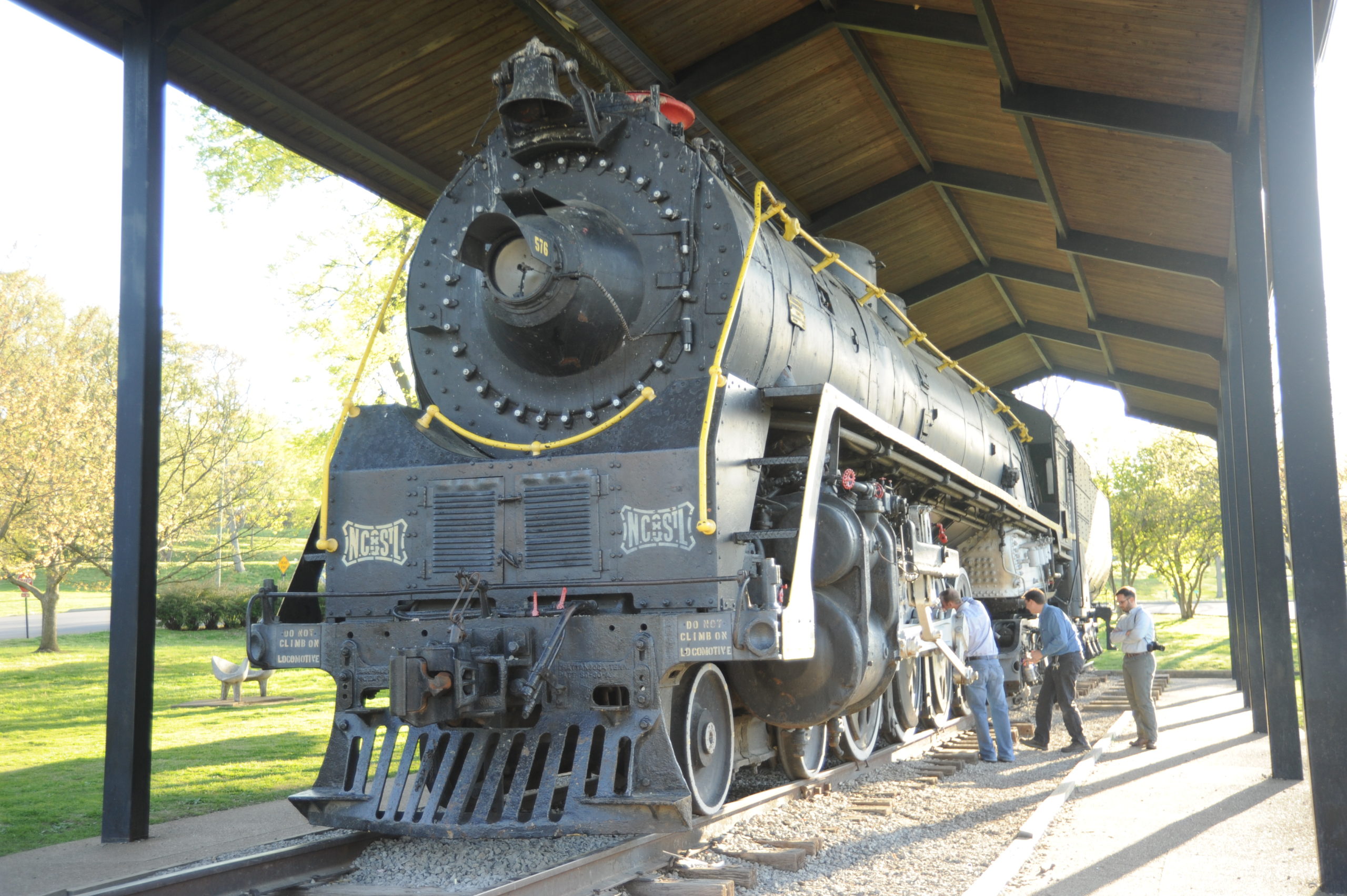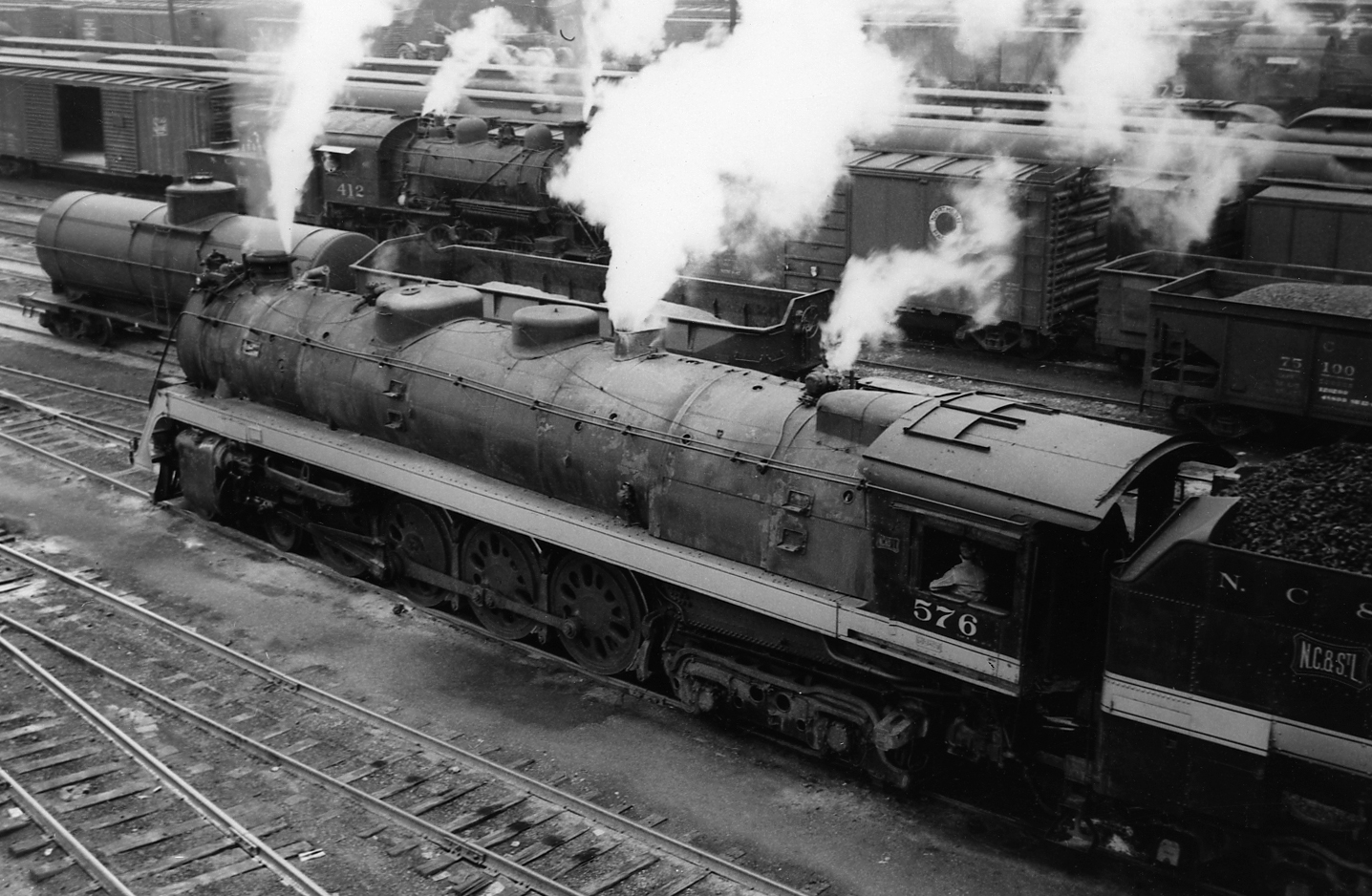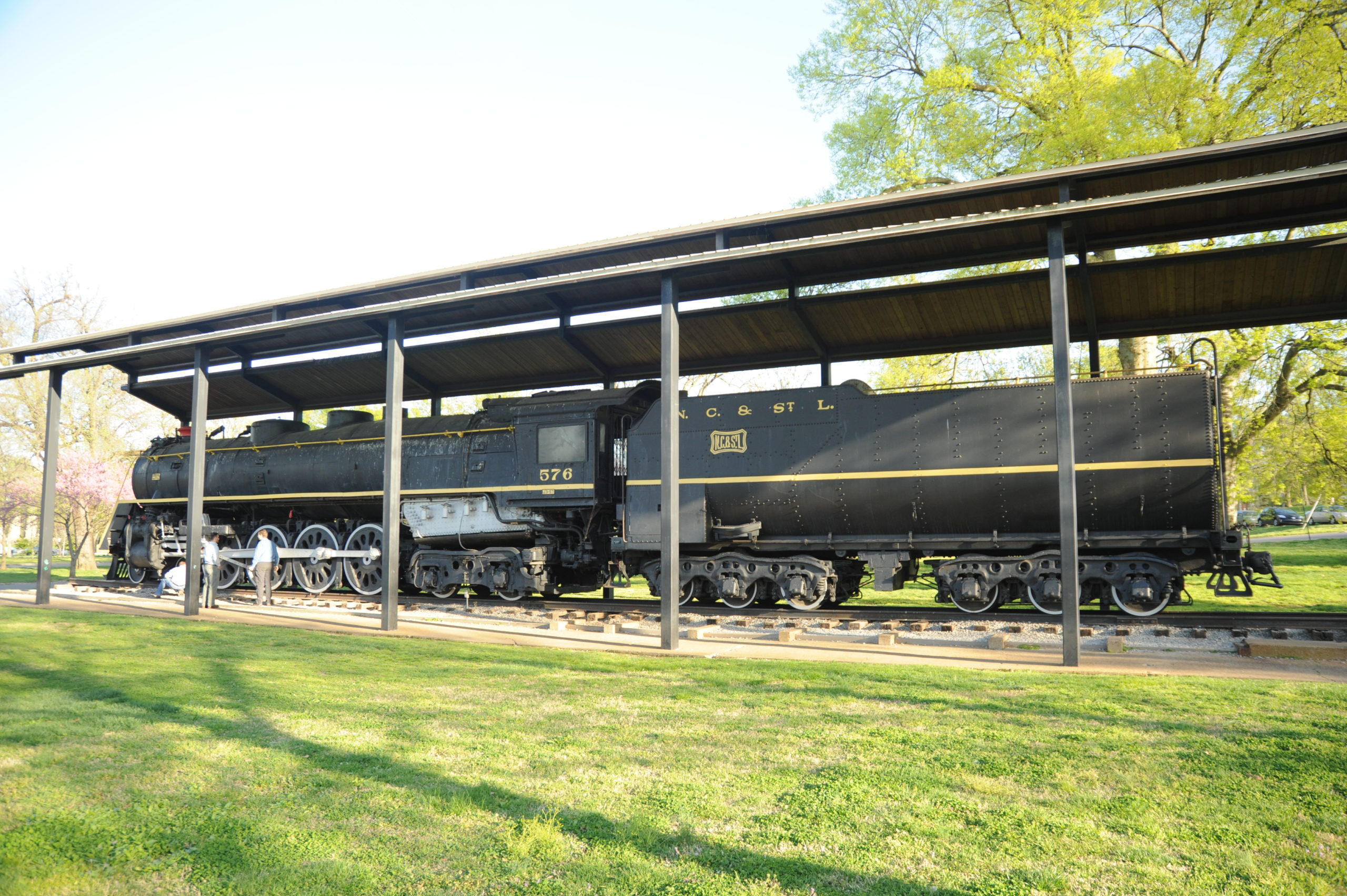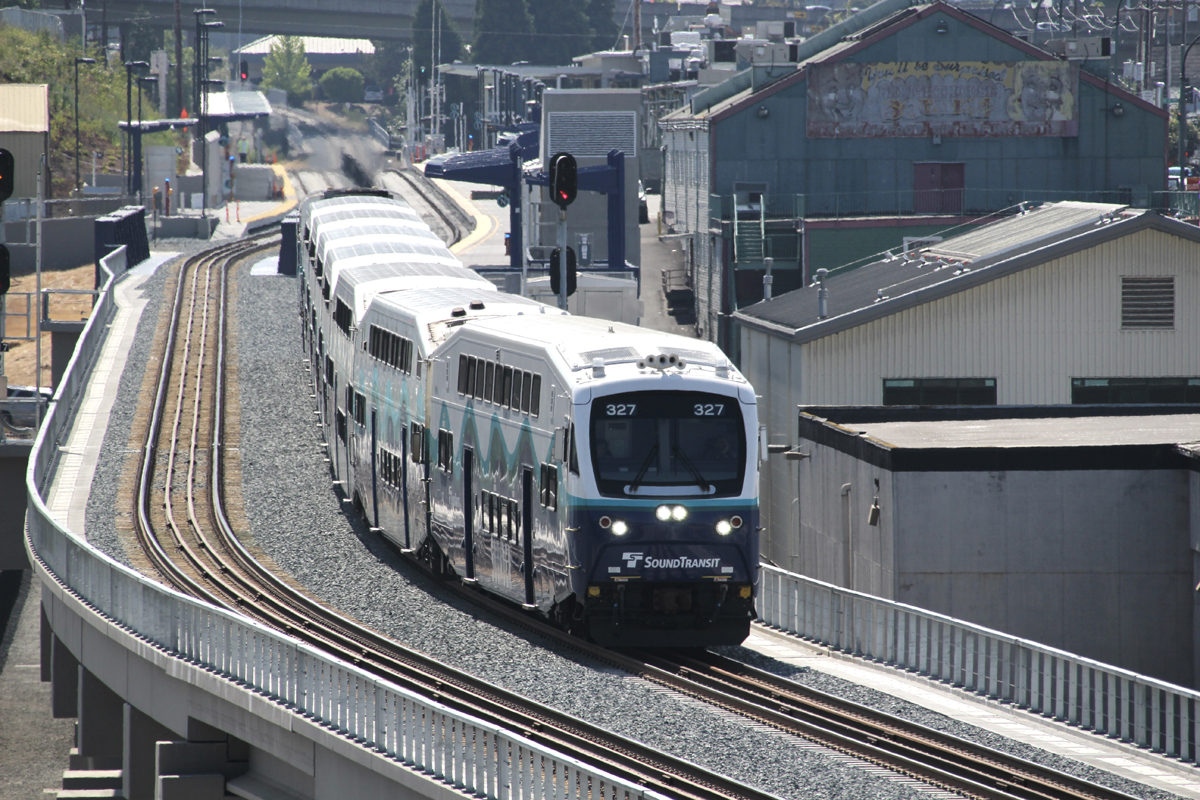Now, though, steam buffs hope the stars are aligning for Nashville, Chattanooga & St. Louis Railway No. 576.
The big J3 engine, the sole survivor of a class of 20 built during the desperate days of World War II, is a 1942 product of the American Locomotive Company. The last time someone proposed removing the 4-8-4 from Centennial Park, in 2001, the parks board declined the offer.
Today, though, “it almost seems as if the timing is right, with all the things coming together,” says Shane Meador, a Nashville native and president and chairman of the recently formed Nashville Steam Preservation Society.
Meador’s $5 million vision calls for leasing 576 from the Nashville Metro government and moving the engine to the Tennessee Central Railway Museum on the Nashville & Eastern Railroad. The restored J3 would lead excursions over the 108-mile N&E — the former Tennessee Central Railway east of Nashville — using 14 passenger cars from the museum’s collection.
Museum President Terry Bebout, who was involved in the failed 2001 effort and is now preservation society vice president, thinks it really could happen this time.
“This is definitely a much better team of people with the professional skills to raise money and do the restoration,” Bebout says. “We didn’t have that the last time we tried to make this happen. This team effort is what’s going to be the success of this project.”
What’s changed in the last 15 years? In 2001, Meador says, “the Music City Star (commuter service) hadn’t happened yet, so the Nashville & Eastern was not capable of supporting the operations of a large steam locomotive.”
Also, the parks board today has a deadline to move 576 somewhere so it can start a major renovation of Centennial Park. Nashville’s historic riverfront has become both a popular tourist draw and home to Riverfront Station, where excursion trains would depart.
Most important, Meador says, “We have the people with the technical skills to make this happen, people who have been involved with over 30 successful steam locomotive restoration projects around the country.”
The preservation society makes its pitch May 3 to the Metropolitan Board of Parks and Recreation. So far, the reception has been positive.
“The opportunity to ride a steam train out of Riverfront Park could be a much richer experience than the current static observation available in Centennial Park and is worthy of consideration,” Parks Directory Tommy Lynch says in a prepared statement issued ahead of the board meeting.
If the parks board goes along, the proposal will go to the Metropolitan Council. If the council approves, 576 could be moved this autumn to the museum. The engine would undergo a four-to-five-year rebuild, with the first trips under steam in the fall of 2020 or spring of 2021.
The preservation society will seek to raise $3 million for the J3’s refurbishment and an additional $2 million to build a visitors center. So far, the group has gotten $200,000 in pledges; donations can be made online.
“We’re not going to touch this project unless we have at least $500,000 in initial capital, which will basically pay for the move to [the museum] … and maintain $100,000 escrow so that in the worst-case scenario we can put the locomotive back together in better condition than when we found it,” Meador says.
The J3 class – not a “Northern” but a “Dixie” to the NC&StL — had its immediate predecessor in the J2, a 1930 design by NC Superintendent of Machinery Clarence M. Darden. A dual-purpose engine for freight and passenger service, the Alco-built J2 had 25-by-30-inch cylinders and 70-inch drivers, weighed 381,000 pounds and exerted 57,000 pounds tractive effort at 250 pounds steam pressure.
It was smaller than a typical 4-8-4 because of the NC’s tight clearances, lightweight bridges and 90-foot turntables. Its total wheelbase of 82 feet, 7 inches compared with 95 feet 4 inches for a Norfolk & Western “J” class like 611.
Yet Darden crammed a lot of innovation into a small package.
Darden also specified a Type E superheater, Worthington 4-S2 feedwater heater, Standard BK stoker, Bradford front-end throttle and four-axle Vanderbilt tenders.
Darden and the NC went back to Schenectady in 1942 for an updated, semi-streamlined version of the J2. The new J3 incorporated the innovations of the prior class and added Timken roller bearings on all axles of the locomotive and tender, Boxpok-type drivers and six-axle conventional tenders.
“What’s also very unique and interesting is Mr. Darden built the locomotive so the appliances and piping were not attached directly to the boiler,” Meador said. “All the pipes are connected to brackets off the frame, including the power reverse valve gear. Darden said a boiler was made to generate steam, not to hang everything on it including the kitchen sink.”
Cylinder size, driver size, tractive effort and boiler pressure were identical to the J2, but the war engine was heavier — 400,500 pounds — and longer, with a total wheelbase of 86 feet 3 5/8 inches. Though it could still fit onto a 90-foot turntable, its overall length of slightly less than 100 feet made that dicey. The NC replaced its turntables with 110-footers in Nashville, Chattanooga and Atlanta, the new engine’s initial home territory.
The J3 also had a conical nose and a broad side skirt that NC’s Nashville Shops painted yellow. Hence the nickname, “Yellow Jacket.” Ten J3s including 576 were delivered in 1942. Ten more followed in 1943 without skirts; they got thin yellow paint lines and were called “Stripes.”
No. 576, Alco builder number 69786, cost $166,500 new, was placed in service Aug. 18, 1942, ran 725,000 miles in freight and passenger duty (losing its nose cone and skirt in 1947) and was retired Sept. 2, 1952.
According to the October 1953 issue of the NC&StL Bulletin employee magazine, 576 could handle a 15-car passenger train or 50-car freight train in the mountains. Her 7-by-11-foot firebox required 1 ½ tons of coal to build a fire. Going all-out, she consumed 4 tons of coal and 7,000 gallons of water an hour.
After the war, the NC was among the first Southern roads to fully dieselize; the end of steam came in January 1953. All the J3s, numbered 570 through 589, were retired in 1951-52, and all were scrapped — except for one. No. 576, saved for the enjoyment of future generations of children, has been in Centennial Park since Sept. 30, 1953.

















YES!!!!!! Another great project! PLEASE support this restoration and send a donation in. The Tennessee Central Railway Museum on the Nashville & Eastern Railroad has a nice long line to run this engine on. Let’s make it happen!!!
Mr. Wrinn, HI! From Green Bay, WI, USA! I met you for a moment at the Title-Town Train Show on Saturday, April 23, 2016, by the booth for the National Railroad Museum, when you asked for their manager, Bob, and 2 young ladies were the attendants. The NRRM is supposed to be celebrating the 60th Anniversary of its foundation in 1956, by the late Mr. Harold E. Fuller plus many business-men who were dyed in the wool steam locomotive fans, who started with just 1 engine with the Milwaukee Road #261, that has since become world famous when in 1992, it was leased by North-Star Rail in Minneapolis. They fulfilled one of the goals established by these late founders, who wanted an operating steam locomotive to pull excursions for future generations. But, unfortunately, it never happened for these founders, while the rest of the excursion and preservation industry expanded by leaps and bounds, and overcoming impossible hurdles. But, instead, this has become a back-water junkyard, filled with unfinished projects that were started over 30 years ago, like the Soo Line wrecking crane #W1, and the unique C&NW Hospital car named the “Joseph Lister” that was used to carry patients to the Mayo Clinic but now stands rusty and forgotten on the back track. The NRRM was enthusiastically promoted as the “Shrine to the Age of Steam”, but no steam engine has run there since 1975, when the well known #29 the “BRILLION PIONEER” 0-4-0T was used, and then another engine was the gear driven Heisler #3 from the Craig Mountain Lumber Co., for special events from 2003 to 2006. But because the NRRM is in a residential park with the neighbor houses only 100 feet from the crossing, the steamers whistles are Extremely LOUD, and the firemen made way too much black smoke. Then the Village stepped in and enforced the ordinance about “Excessive noise and smoke”. So if the Museum had just run the steamers in a more professional manner, there wouldn’t be all these problems. And yet, more problems occurred after 1980 when an outside manager was hired to run the Museum. But instead, they began to sell engines and cars, and worse, scrap and destroy them, like the 50 ton Plymouth center-cab gas electric from the Cassville and Exeter RR shortline in Missouri, and nicknamed “MIGHTY MITE” that was used as a switcher at the museum from 1962 to 1963 when it brokedown. But in 1986, the outsiders unly saw a rusty old engine that was useless, so it was scrapped and destroyed. Yet I also got pictures of the scrapping, and many of the other pieces destroyed, like the 4-barrel pickle car, and the steam powered crane from the Appleton Paper Co. The NRRM should have 93 engines and cars, but with the selling or destruction of 37 pieces, there are only 56 pieces left. It just needs more track, and a complete changeover into a competent and responsible management that has a railroad background and an appreciation for the volunteers in the area, like the model railroad club in Hood Jct. depot that was forcibly evicted from the depot after 19 years. Please join with us to make this museum a source of pride again, PLEASE!
I can’t wait to ride on that train !
I know and highly respect Shane Meador. IF (and it’s a big IF) the City Fathers–OOPS-the Metro Nashville & Davidson County Fathers) will cooperate with him on this, it’s still going to be a huge job. If the monies can be raised, move over, 611, heah comes Miss Dixie! I wish ’em all the luck in the world!
As I recall, this locomotive was to be restored by the Southern before the 611 was chosen. Nashville’s city fathers declined the offer, so now we have the 611. And now it seems the city fathers want the land more, so I guess we may have TWO 4-8-4’s in the south. You can go home again. DPM must be smiling quite broadly by now. Mr. Wrinn, seems your adventures are only beginning!
Being a Middle Tennessee resident since 1969, I have seen several attempts to remove and restore this engine stopped for one (stupid) “reason” or another. I very much hope this latest attempt succeeds.
Many thanks to Jim Wrinn and Trains Magazine for sharing this exciting news and encouraging this, and other restoration efforts.
And of course the bigger picture nationwide is the interest, and one hopes the dollars, in steam restoration. There are many to thank, not least Steve Sandberg and the Friends of 261 here in the midwest.
The NERR is actually closer to 130 miles long and currently hosts TCRM excursions the whole length. Having such an engine having access to such a route will make for great outings!
As a rare young Dixie Line fan I am very hopeful that everything goes well. The city has severely neglected this engine almost to the point of abuse so it’ll be a lot of work to bring her up to steam again.
Sounds like a perfect candidate for restoration-especially with roller bearings on all axles. Now, if they could just add a conical nose and skirt……………..